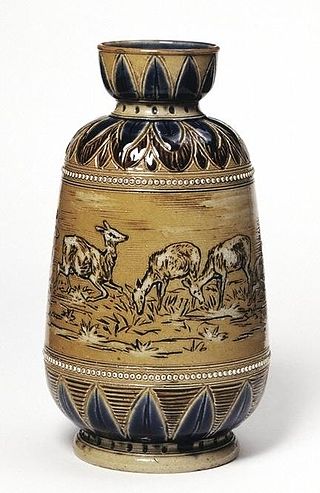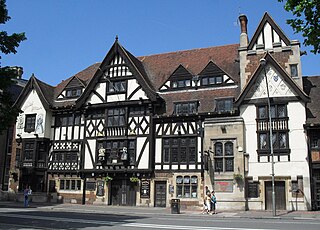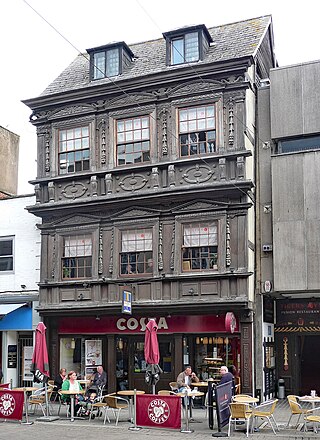
The William Morris Gallery is a museum devoted to the life and works of William Morris, an English Arts and Crafts designer and early socialist. It is located in Walthamstow at Water House, a substantial Grade II* listed Georgian home. The extensive grounds of the building are a public park, known as Lloyd Park.

Exeter St Davids is the principal railway station serving the city of Exeter in Devon, England. It is 193 miles 72 chains from the zero point at London Paddington on the line through Bristol which continues to Plymouth and Penzance. It is also served by an alternative route to London Waterloo via Salisbury and branch lines to Exmouth, Barnstaple, and Okehampton. It is currently managed by Great Western Railway and is served by trains operated by Great Western Railway, South Western Railway and CrossCountry.

Royal Doulton is an English ceramic and home accessories manufacturer that was founded in 1815. Operating originally in Vauxhall, London, and later moving to Lambeth, in 1882 it opened a factory in Burslem, Stoke-on-Trent, in the centre of English pottery. From the start, the backbone of the business was a wide range of utilitarian wares, mostly stonewares, including storage jars, tankards and the like, and later extending to drain pipes, lavatories, water filters, electrical porcelain and other technical ceramics. From 1853 to 1901, its wares were marked Doulton & Co., then from 1901, when a royal warrant was given, Royal Doulton.

Kings Weston House is a historic building in Kings Weston Lane, Kingsweston, Bristol, England. Built during the early 18th century, it was remodelled several times, the most recent in the mid-19th century. The building was owned by several generations of the Southwell family. By World War I, the house was used as a hospital and then later used as a school by the Bath University School of Architecture. The building is today used as a conference and wedding venue, as well as a communal residence.

Armada House is on Telephone Avenue, off Baldwin Street, Bristol.

The Printers Devil was a historic pub in Bristol, England.

The Carriage Works are in Stokes Croft, Bristol, England.

Cheltenham Town Hall is an early-20th century assembly rooms in Cheltenham, England. Unlike most town halls, it is a public venue and not the seat of the borough council, which is housed in the nearby Municipal Offices. It is a Grade II listed building.

The Modern Style is a style of architecture, art, and design that first emerged in the United Kingdom in the mid-1880s. It was the first Art Nouveau style worldwide, and it represents the evolution of the Arts and Crafts movement which was native to Great Britain. The Modern Style provided the base and intellectual background for the Art Nouveau movement and was adapted by other countries, giving birth to local variants such as Jugendstil and the Vienna Secession. It was cultivated and disseminated through the Liberty department store and The Studio magazine.

Broad Street, along with High Street, Wine Street and Corn Street, is one of the four original streets that have made up the city of Bristol since Saxon times, when it was the burgh of Brycgstow.

Manchester School of Art in Manchester, England, was established in 1838 as the Manchester School of Design. It is the second oldest art school in the United Kingdom after the Royal College of Art which was founded the year before. It is now part of Manchester Metropolitan University.
The Imprint was a periodical aimed at the printing trade, published in 9 issues from January to November 1913. The publishers were the Imprint Publishing Company, of 11 Henrietta Street, Covent Garden, London. Editors were F. Ernest Jackson, Edward Johnston, J. H. Mason, and Gerard Meynell of the Westminster Press, London, which was also the printer of the journal.
Clayton & Black were a firm of architects and surveyors from Brighton, part of the English city of Brighton and Hove. In a career spanning the Victorian, Edwardian and interwar eras, they were responsible for designing and constructing an eclectic range of buildings in the growing town of Brighton and its neighbour Hove. Their work encompassed new residential, commercial, industrial and civic buildings, shopping arcades, churches, schools, cinemas and pubs, and alterations to hotels and other buildings. Later reconstituted as Clayton, Black & Daviel, the company designed some churches in the postwar period.

The King and Queen is a pub in the seaside resort of Brighton, part of the city of Brighton and Hove. The present building, a "striking" architectural "pantomime" by the prolific local firm Clayton & Black, dates from the 1930s, but a pub of this name has stood on the site since 1860—making it one of the first developments beyond the boundaries of the ancient village. This 18th-century pub was, in turn, converted from a former farmhouse. Built using materials characteristic of 16th-century Vernacular architecture, the pub is in the Mock Tudor style and has a wide range of extravagant decorative features inside and outside—contrasting with the simple design of the neighbouring offices at 20–22 Marlborough Place, designed a year later. English Heritage has listed the pub at Grade II for its architectural and historical importance.

The Grand Hotel is a Grade II* listed Victorian five star hotel in the city centre of Birmingham, England. The hotel occupies the greater part of a block bounded by Colmore Row, Church Street, Barwick Street and Livery Street and overlooks St Philip's Cathedral and churchyard. Designed by architect Thomson Plevins, construction began in 1875 and the hotel opened in 1879. Extensions and extensive interior renovations were undertaken by prominent Birmingham architecture firm Martin & Chamberlain from 1890 to 1895. Interior renovations included the building of the Grosvenor Room with Louis XIV style decoration.

Pope's villa was the residence of Alexander Pope at Twickenham, then a village west of London in Middlesex. He moved there in 1719 and created gardens and an underground grotto. When Baroness Howe of Langar (1762–1835) purchased the house, she demolished it in 1808 and built a new house next to the site. The house and grotto were topics of 18th- and 19th-century poetry and art. In about 1845, a neo-Tudor house known as Pope's Villa was built on approximately the same site; it has been used as a school since the early 20th century. Pope's Grotto, which is listed Grade II* by Historic England, survives and is occasionally open to the public.

9 and 9A Southgate Street is a 17th-century Jacobean timber-framed merchant's house on Southgate Street, Gloucester. It has been a Grade I listed building since 23 January 1952. 9 Southgate Street is now occupied by Costa Coffee and 9A Southgate Street is occupied by The Tiger's Eye restaurant.

Bristol Guildhall is a municipal building in Broad Street, Bristol, England. It is a Grade II* listed building. It was built in the 1840s on the site of the previous guildhall and used as a courthouse from the 1860s to 1993. Various plans for its use as an art gallery and hotel were then proposed. In March 2020 it was damaged by a fire which led to its roof collapsing.

Fred Baker was an English architect working in Lincoln, Lincolnshire.

William James Neatby, often W. J. Neatby, was an English architect, designer and artist. He is best known for his designs of architectural ceramics and was Doulton and Co.'s chief ceramic designer. His standout works include the Meat Hall in Harrods (London), and Everard's Printing Works (Bristol). The Modern Style of the Everards Printing Works facade is the largest decorative Doulton Carrara ware tile facade of its kind in Britain. Neatby was among leading British artists during the late 19th and early 20th century. Ernest Augustus Runtz said of him: "He was a true artist, and a man of fine character, and he pursued his art with a direct and single purpose."



















